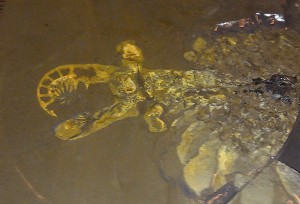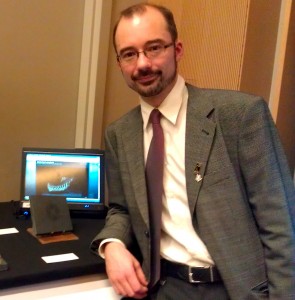
Ever since I started this blog, I’ve been looking for an excuse to write about the Burgess Shale, a national treasure of science that has somehow remained a secret to many Canadians. Discovered over 100 years ago, these sedimentary deposits – situated on top of a mountain in British Columbia’s Yoho National Park – remain unsurpassed as the richest source of well-preserved fossils from the Cambrian period, which stretched from about 540 to about 490 million years ago. Hundreds of thousands of Burgess fossils have been recovered, and the story they tell constitutes a rare and vital peek into the beginnings of complex life on earth. Despite this, most Burgess fossils are only accessible to a handful of experts, and there are few places you can go to learn about them first-hand. All that changed on Thursday, when I was fortunate enough to be present at the launch of a new website dedicated making the Burgess Shale fossils accessible to all Canadians, and indeed the entire world. As Parks Canada CEO Alan Latourelle aptly put it, the Burgess fossils are “a secret worth sharing.”
So what’s so special about the Cambrian period? To understand this, you have to know that for most of Earth’s history – over 2.5 billion years – all life was microscopic. In the ocean, single-celled cyanobacteria eked out a living, using sunlight to convert carbon and water into energy and the oxygen that would eventually fill our atmosphere. Other microbes grazed on the photosynthesizers. During the Ediacaran period, some rare life forms –it’s not totally clear what they were – managed to organize themselves into flat, fan-like structures big enough to be seen with the naked eye. But for the most part, life remained invisible until the Cambrian when suddenly, for reasons we still don’t fully understand, macroscopic life went bananas. The seas crawled with creatures that we would recognize as sponges and worms, multi-legged arthropods and molluscs with trailing tentacles. For the first time, representatives of almost every major modern phylum show up in the fossil record, including one tantalizing example of chordates, which today include all fish, amphibians, reptiles and mammals.
Yet most of this life was still invisible to the fossil record for one simple reason: most animals were soft-bodied. With some exceptions, notably the ubiquitous trilobites (armoured arthropods distantly related to insects and crustaceans) fossilized Cambrian animals are hard to come by. That’s why the Burgess Shale is so unique; it’s the result of a series of catastrophic underwater mudslides that almost instantly buried thousands of creatures, preserving them like flowers in the pages of a book. In some cases you can even see footprints and dung they left behind in the mud. Half a billion years later the deposits, now resting on top of a mountain, were discovered by the American palaeontologist Charles Doolittle Walcott, and scientists have been studying them and debating about what they mean ever since. That story has been well told in books like Stephen Jay Gould’s Wonderful Life and indeed on the website that was launched this week. So rather than tell it again, let me instead introduce you to Jean-Bernard Caron.

Caron has been passionate about paleontology since he was ten years old. As a student in France, he read Wonderful Life and decided that he had to see those amazing fossils first-hand. Eventually he got in touch with Desmond Collins, then Curator of Invertebrate Paleontology at the Royal Ontario Museum. At the time, Collins was building the ROM’s collection of Burgess Shale fossils into the biggest one in the world by organizing a series of expeditions to the site. He agreed to take on Caron as a master’s student. Caron continued to work at the ROM for his PhD, and by the time he was done, he had personally examined over 70,000 Burgess Shale fossils. He estimates that there are probably about 150,000 in the ROM’s collection, but it could be even higher. “We don’t actually know how many specimens we have in our collections,” he told me over the phone. “On a single slab you can have several specimens. In the field, when you collect a fossil, you usually don’t have time to identify everything on the slab. What we have is probably around 35,000 to 40,000 pieces of rocks, and each of them has somewhere between 5 or 8 specimens.”
When Collins retired in 2006, Caron took over his position. It was his idea to create a website that would enable all Canadians to experience the collection for themselves. “The website is the best way to display a lot of specimens; on the floor you would have problems of space and funding” he says. “The other advantage is to be able to tell a more thorough story, and you can organize information so that it can be found quickly.” Building the website was hard work; it took years of dedicated effort by staff at the ROM and Parks Canada, not to mention the technical work which was carried out by groups from around the world. But the result speaks for itself: it is simply the most comprehensive depiction of the subject available on the web, including hundreds of photos of the fossils, animations, videos, scientific descriptions, history of the site, resources for teachers, and even a link to the “fossil cam.”

For most visitors, the attraction will be the main gallery, where over 130 different species are profiled in all their splendour. Looking through the thumbnail images, and detailed descriptions, I couldn’t help but be reminded of Pokémon: each one seems to have its own amazing abilities, although we know that they all must have coexisted in the same ecosystem. Probably the most famous animal in the gallery is Anomalocaris canadensis. The name means “strange shrimp of Canada,” and is appropriate considering the bizarre story of its discovery. Anomalocaris was discovered in pieces; its jaws were found first and classified as the body of a shrimp, since that’s exactly what they look like. Its mouth, which looks like a pinapple slice, was described by Walcott as a jellyfish called Peytoia nathorsti. And its body was thought to be the body of a sea cucumber called Laggania cambria. It took until the 1990s to sort out the mess, but we now know that Anomalocaris was one of the top predators of that Cambrian world, swimming through the water and looking for prey with its huge eyestalks. [Update: its eyes rival even the best compound eyes in modern arthropods, according to the cover story in Nature that appeared less than a week after I posted this]
There are so many more creatures to discover, including Hallucigenia sparsa, a worm with spikes on its back and leg-like appendages, and Pikaia gracilens, one of the earliest examples of an animal with a backbone and the one most closely related to us. While it wouldn’t be quite right to think of the Cambrian animals as our direct ancestors, it is fair to say that they represent our best glimpse of the ancient world in which our forebears lived, and that in a very real way we are still connected. “This is a story for everybody,” says Jean-Bernard Caron, “because at its core, it’s a story about life.”
To check out the Burgess Shale website produced by the Royal Ontario Museum and Parks Canada, click here.
To hear an edited version of my conversation with Jean-Bernard Caron about the Cambrian explosion and the new website, click below.
1 Comment
[…] I mentioned in a previous post, the Burgess Shale is located in British Columbia’s Yoho National Park. It is the world’s […]